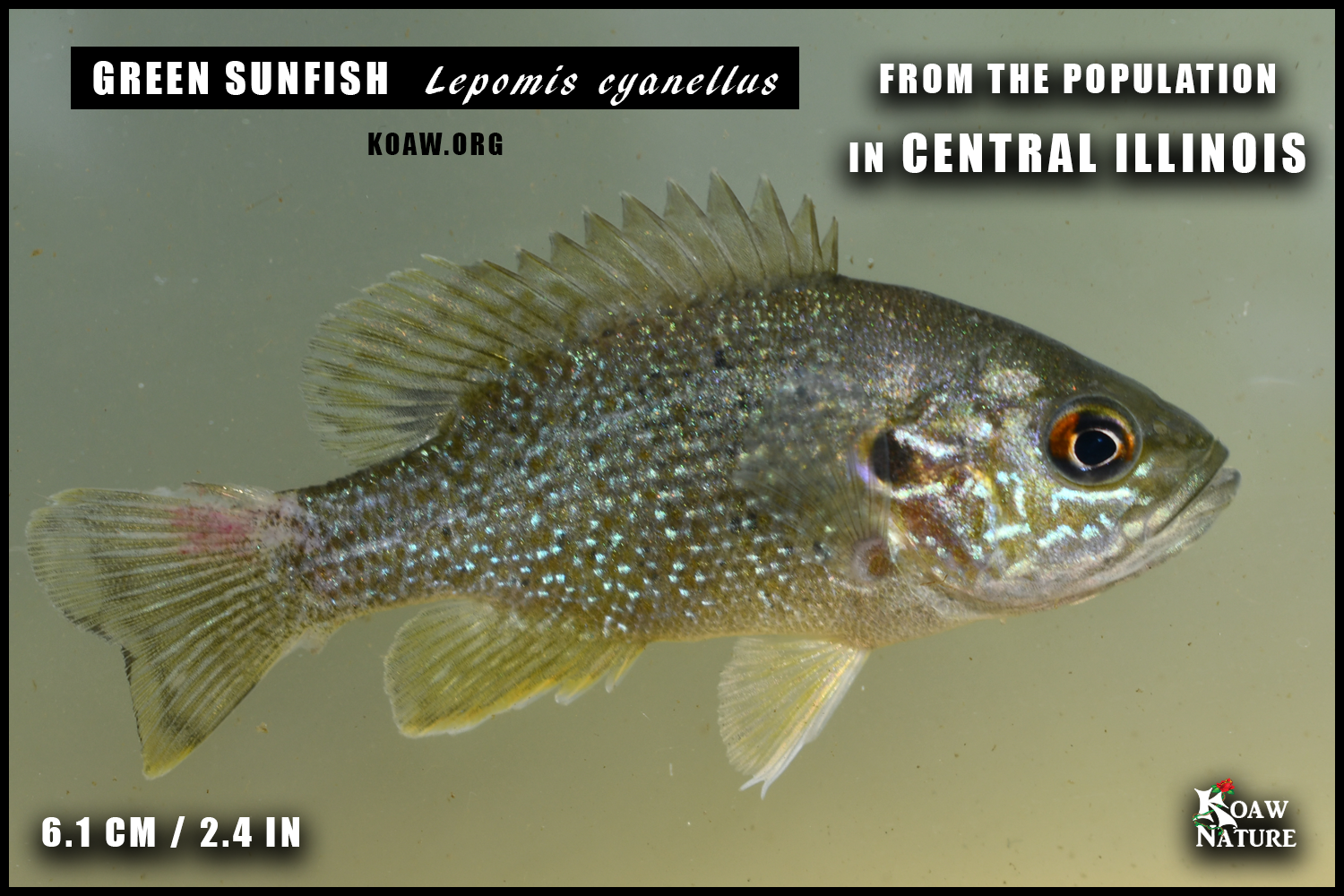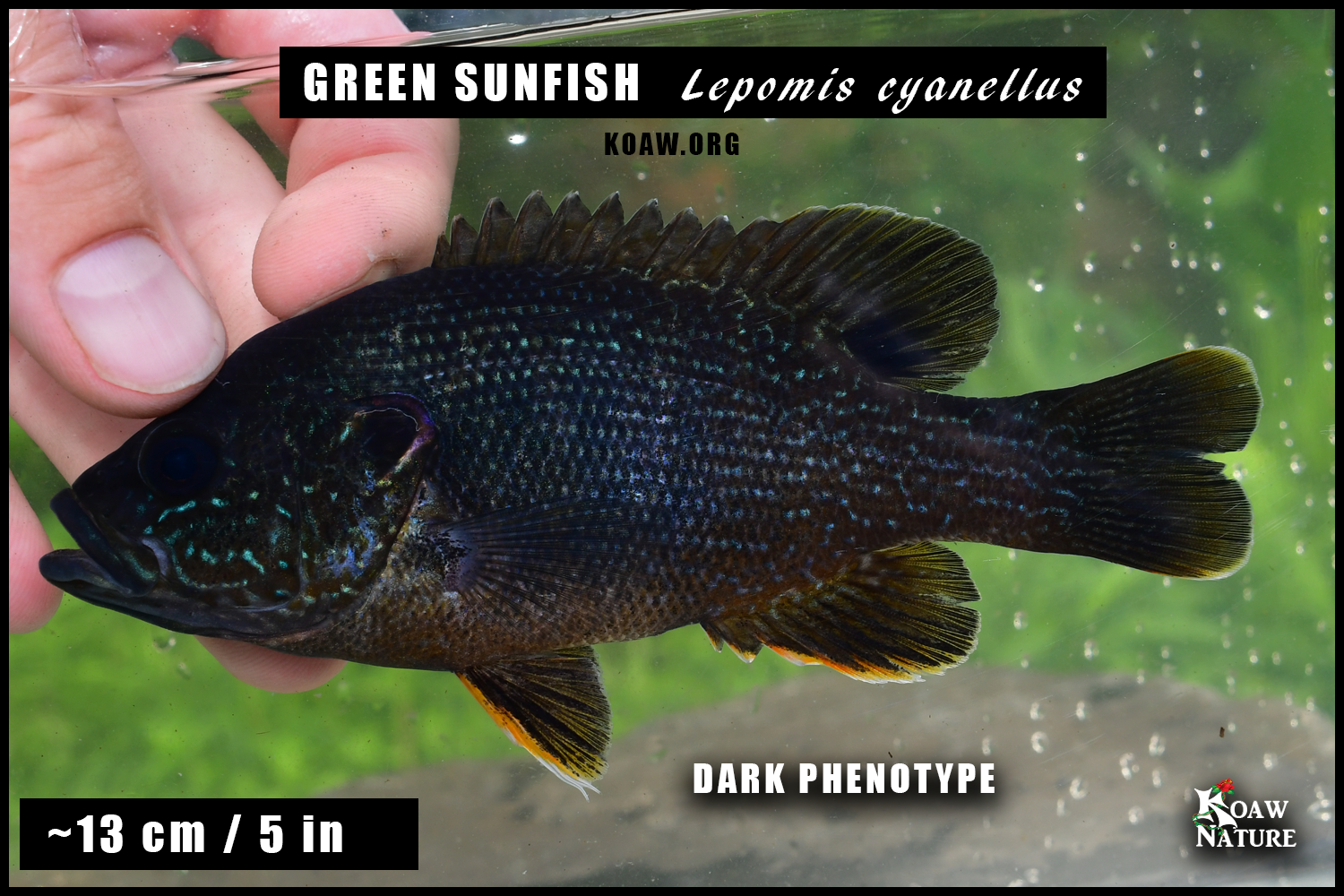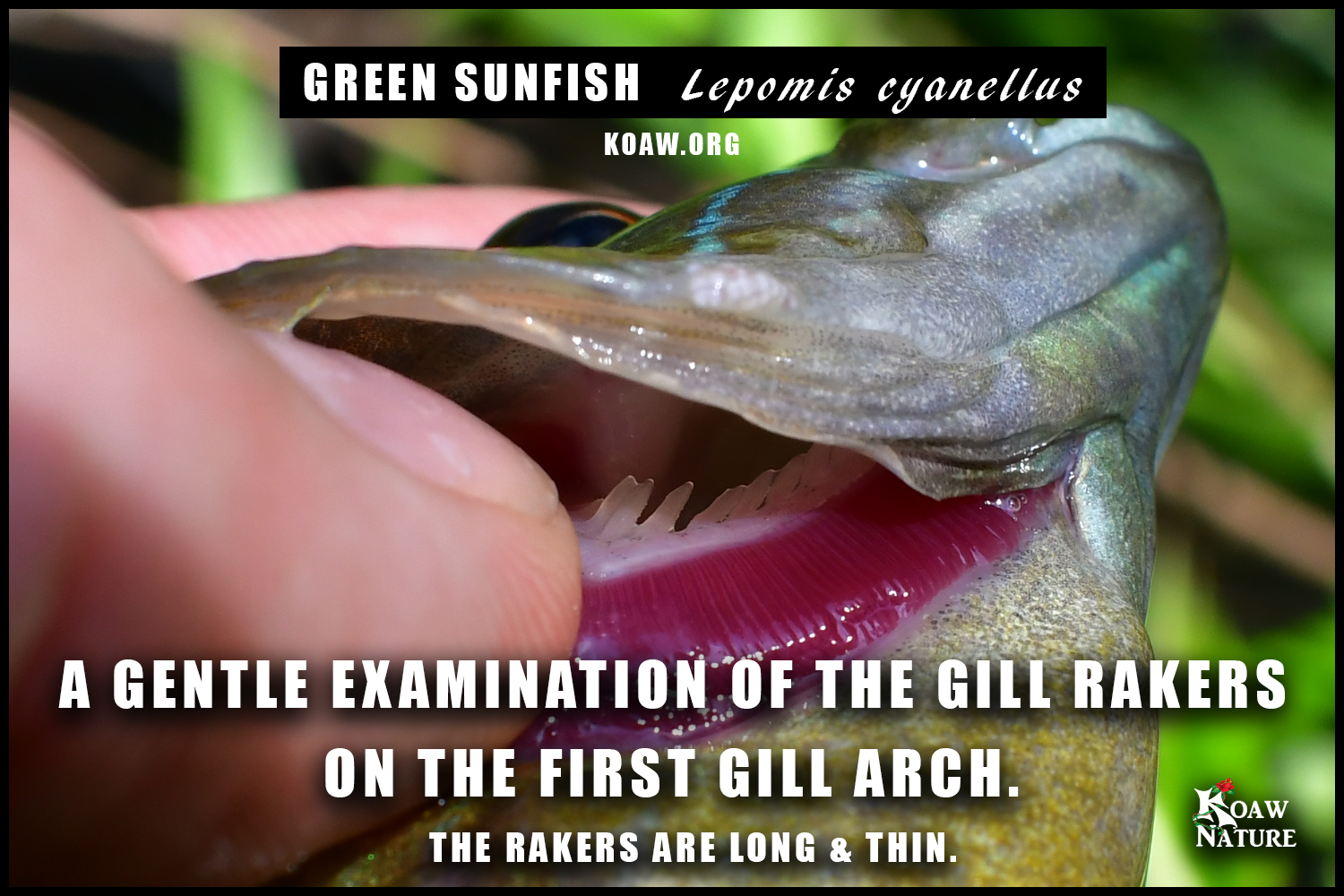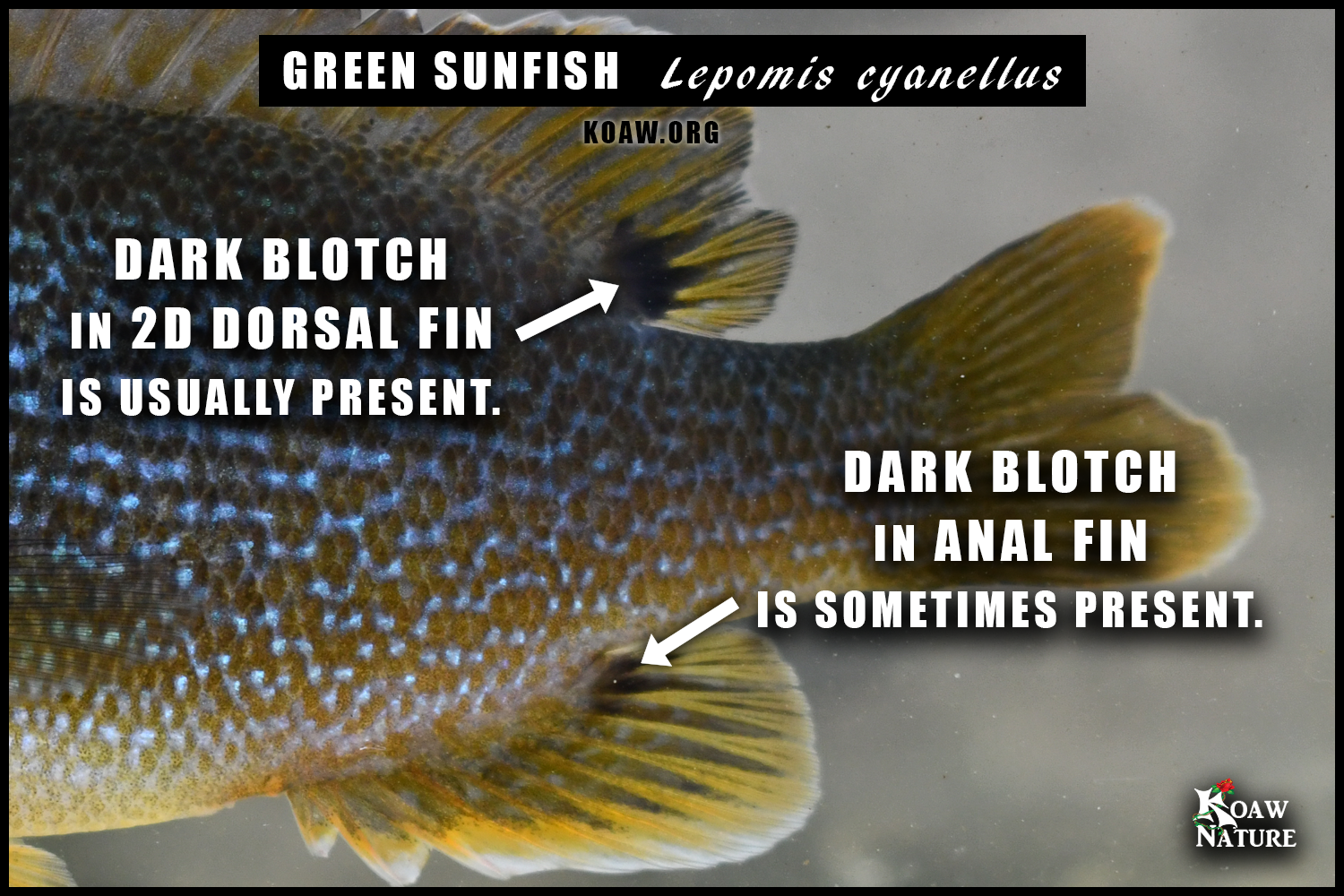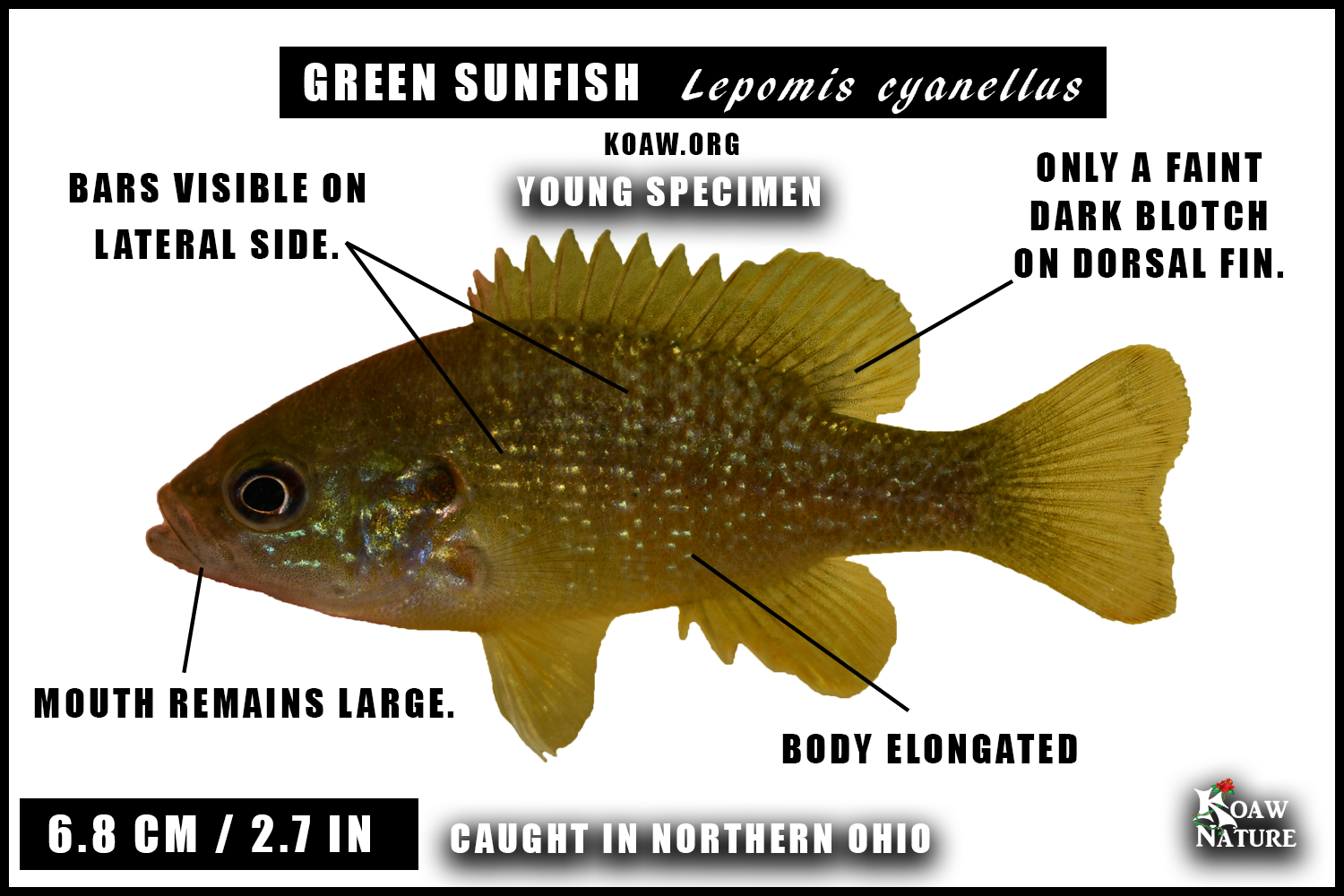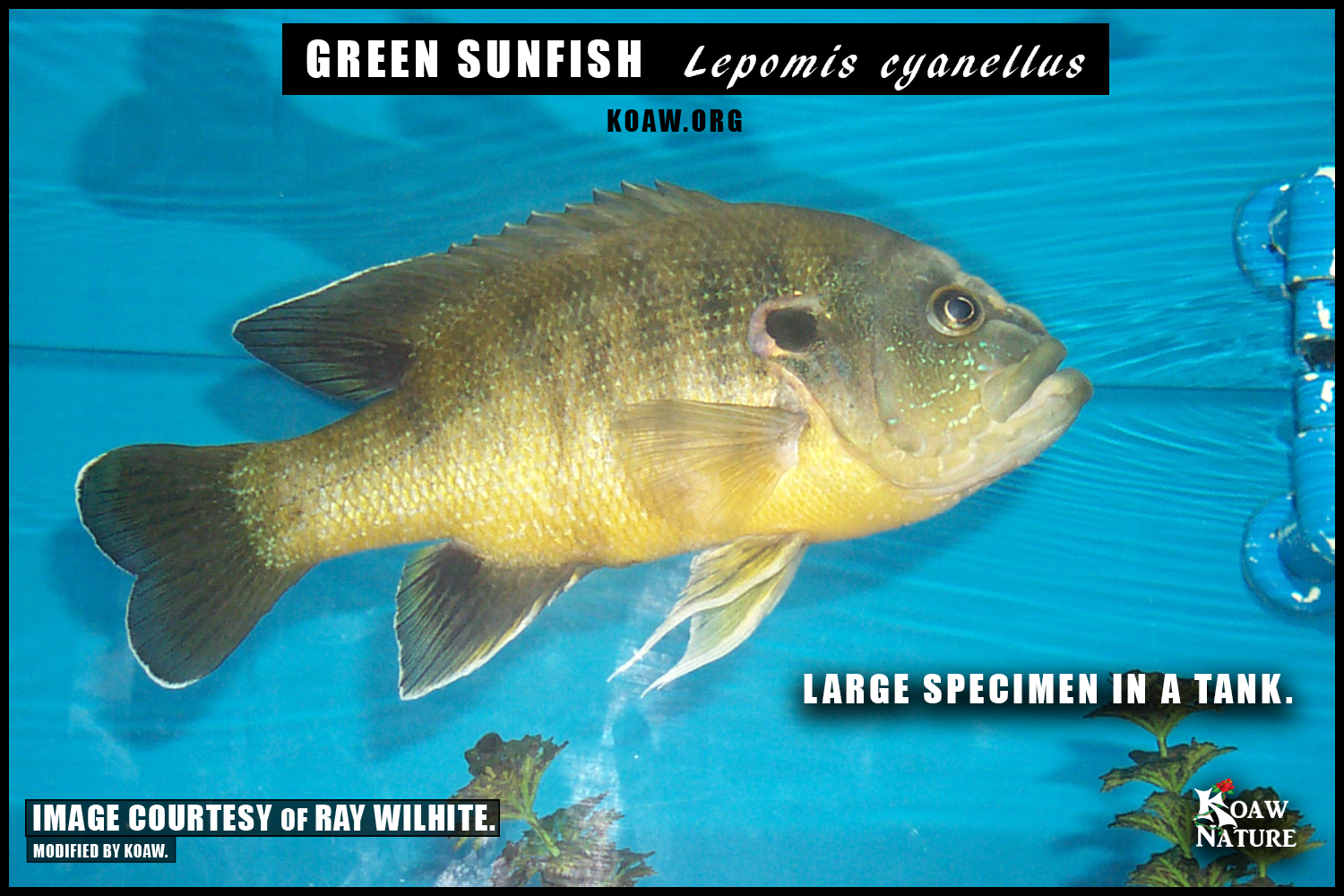By Koaw - November, 2020 (Updated - July, 2022)
GENERAL: The green sunfish (Lepomis cyanellus - Rafinesque 1819) is a beautiful species that often possesses many colors and vibrant blue streaks on the head. The large mouth, elongated body, dark blotches in the median fins, and cream edging on the fins are great distinguishing features.
Click on the graphic to enlarge.
The green sunfish is one of the most promiscuous hybridizers of all lepomids. In the wild, the green sunfish has successfully created offspring with at least seven other species of lepomids: bluegill (L. macrochirus), pumpkinseed (L. gibbosus), redear sunfish (L. microlophus), orangespotted sunfish (L. humilis), redbreast sunfish (L. auritus), longear sunfish (L. megalotis), and warmouth (L. gulosus). [1] [2] The greengill, or the crossing of a green sunfish and bluegill, is one of the most commonly encountered lepomid hybrids, both in nature and in aquaculture. [3] [4] [5] [6] Please see my “Introduction to Hybrids” page to learn more about lepomid hybrids.
Typically 3 anal spines, 9 (8) anal rays, 13-14 pectoral rays, 10 dorsal spines and 10-11 dorsal rays. [7][8]
BODY: The green sunfish, like all sunfishes within Lepomis, has a compressed, deep body. Compared to its congeneric relatives (species within the genus), the mature green sunfish has a much more elongated body as the appearance from the lateral side is more fusiform like a football rather than roundly.
This species often hybridizes with other sunfishes such as bluegill. The lateral line is complete with 41-53 lateral scales. [1]
COLORATION: White, cream and orange colored margins exist on the median and pelvic fins. Dark orange blotches are often present in the interradial membranes of the median fins. A dark blotch is often found on the 2d dorsal fin (similar to a bluegill) while another dark blotch may be present on the anal fin, though not all mature specimens will have this blotch on the anal fin. I had hypothesized that this dark blotch on the anal fin was only present on males; after verifying the sex of a number of individuals, I found that females also may have this second blotch on the anal fin. The coppernose bluegill (Lepomis macrochirus purpurascens), a subspecies of the bluegill, is the only other lepomid to have both a dark blotch on the 2d dorsal fin as well as the anal fin; rarely does the bantam sunfish (L. symmetricus) have a dark blotch on the anal fin. [9]
Wavy and shiny blue/green lines extend laterally from the mouth to the cheek and into the operculum. The upper body most often is a darker shade of greenish blue with metallic blue/green/yellow flecks. The blue flecks make the appearance of incomplete lines running laterally along the body. The belly is often white to yellow in color. [7] Several lateral bars are often faintly present on the sides but can be pronounced on some specimens. The green sunfish tends to have a darker overall appearance than the majority of other sunfishes. [10] I have caught plenty of specimens that appear almost entirely black (see image in carousel above as well); these were caught in confined outlets of lakes as well as in turbid waters and likely tannin-rich waters.
The green sunfish often has limited-to-none blue or turquoise color on the upper lip that is broken and does not extend across the entirety of the lip. Often this blue color is limited to the lateral sides on the upper lip. The longear sunfish (Lepomis megalotis) typically has an upper lip that has blue streaking across the entirety of the upper lip.
SIZE: To 12 in (31 cm). [7] IGFA All-Tackle World Record 0.96 kg (2 lb 2 oz). [11]
OPERCULAR FLAP: The green sunfish has a short “ear flap” at the posterior edge of the operculum. Often there is a white to yellow anterior edging with slight red to orange color along the posterior edge. There is much iridescence both along the edging and atop the black portion of the flap. Depending on the angle of light and point of perspective between the flap and viewer, the black portion of the earflap may appear mostly red, purple or orange.
Often the red, purple and white edging of the ear flap will be faded and blended, not appearing as two-toned as it would be on certain other sunfishes, like a pumpkinseed. The colored-edging may not be present on the dorsal side of the ear flap.
GILL RAKERS: The gill rakers of the green sunfish are long and thin. These can be observed by gently lifting the gill plate and examining the white portion above the red filaments that are closest to the gill plate.
I made a video describing how to locate and find these rakers that is hosted on Koaw Nature’s Fishing Smarts YouTube channel.
MOUTH SIZE: A very large mouth exists on the green sunfish. The upper jaw will extend underneath the pupil of the eye.
More specifically, the most posterior edge of the maxilla will align underneath or past the anterior edge of the eye’s pupil.
PECTORAL FIN: The pectoral fin is short and roundly, usually not extending past the posterior end of the eye if bent forward. The pectoral fin may be longer on some specimens, rarely passing the middle of the pupil if bent forward.
There are often 13-14 pectoral rays. [7][8]
HABITAT: The green sunfish is found in backwaters of creeks/streams and often associated with vegetation in lakes and ponds. [7] [10] Also found in sluggish waters of rivers. Various size impoundments near larger bodies of water may also hold green sunfish.
This species is often associated with cover. Shorelines with big boulders and fallen trees are great spots to find greens. I’ve lured many a green out of fallen trash along shorelines such as tires and buckets.
CLICK TO ENLARGE - This distribution map is an illustrated approximation created by Koaw primarily pulling data and information from USGS-NAS, Research Grade observations from iNaturalist and Page & Burr’s Field Guide to Freshwater Fishes.
LOCATION: Native to the Great Lakes Basin and Mississippi River Basin to Gulf Slope drainages. Also native to the Rio Grande Basin including the Pecos River in New Mexico, down into Texas and in parts of Northern Mexico. [7] [12]
The green sunfish is widely introduced across North America. It is now very common in Pacific drainages from Washington down the coast into California and Mexico. East coast introductions have the fish existing in areas around Montreal all the way to Georgia. [13] [12]
Koaw shows you how to catch a green sunfish.
FISHING: Green sunfish are often cohabitating with other species of sunfishes. This species, from my observations, tends to act more like warmouth as the green sunfish stays lower in the water column and closer to hiding spots.
Green love cover. Keep an out of for little caves or ledges that green sunfish can hide under; (video example link.) They often embrace the lie-and-wait hunting method.
Quite often I’ll be fishing a shoreline of a lake and casting out towards the middle where I’ll primarily be catching bluegill, redear or other species. But standing in that same spot, a cast parallel to the shoreline at about 1.5 m (4.5 ft) away, I’d pull up mature green sunfish hiding in the rocks and vegetation.
In creeks, where the cohabitation was a bit more crowded, I found the bluegill would always be hitting the bait first. Using larger baits/hooks let most of the bluegill not succeed in taking the bait while the larger mouth on the green sunfish was able to take a bait with a larger hook.
Flies of various types were successful in capturing this species as well as live worms and cut pieces of worms.
SIMILAR SPECIES: The green sunfish and bluegill are not often confused with one another, but it does happen. This side-by-side comparison is actually a great reference for new sunfish identifiers because it shows much of the range of all lepomid species for many characteristics.
REFERENCES:
W. F. Childlers, "Hybridization of Four Species of Sunfishes (Centrarchidae)," Bull. Ill. Nat. Hist. Surv., vol. 29, no. 3, 1967.
C. L. Hubbs and A. I. Ortenburger, "Further Notes on The Fishes of Oklahoma with Descriptions of New Species of Cyprinidae," PUBL. UNIV. OKLA. BIOL. SURV., vol. 1, no. 2, pp. 17-43, 1929.
C. D. Webster and H. J. Tidwell, "Centrarchids: Hybrid Bluegill (Lepomis cyanellus x Lepomis macrochirus)," in Nutrient Requirements and Feeding of Finfish for Aquaculture, CAB International, 2002, pp. 381-387.
W. F. Childers and G. W. Bennett, "Hybridization Between Three Species of Sunfish (Lepomis)," Illinois Natural History Biological Notes, vol. 46, pp. 1-15, 1961.
D. A. Etnier, "Reproductive Success of Natural Populations of Hybrid Sunfish in Three Minnesota Lakes," Transactions of the American Fisheries Society, vol. 97, no. 4, pp. 466-471, 2011.
iNaturalist, "Lepomis macrochirus × cyanellus Greengill Sunfish," iNaturalist, [Online]. Available: https://www.inaturalist.org/taxa/1102243-Lepomis-macrochirus---cyanellus. [Accessed 2020].
L. M. Page and B. M. Burr, Peterson Field Guide to Freshwater Fishes, Houghton Mifflin Harcourt Publishing Company, 2011.
Koaw, "Meristics and Morphometrics of Lepomids," 2020. [Online]. Available: https://www.koaw.org/lepomid-data.
B. M. Burr, "The Bantam Sunfish, Lepomis symmetricus: Systematics and Distribution, and Life History in Wolf Lake, Illinois," Natural History Survey Division, vol. 31, no. 10, pp. 437-466, 1977.
R. P. Jacobs and E. B. O'Donnell, "Sunfishes and Freshwater Basses," in Freshwater Fishes of Connecticut, Hartford, Connecticut Dept. of Environmental Protection, 2009, pp. 164-180.
IGFA, "IGFA World Record Green Sunfish Lepomis cyanellus," [Online]. Available: https://igfa.org/igfa-world-records-search/?search_type=ScientificName&search_term_1=Lepomis&search_term_2=cyanellus. [Accessed 2020].
USGS - NAS, "Lepomis cyanellus," [Online]. Available: https://nas.er.usgs.gov/queries/SpeciesAnimatedMap.aspx?SpeciesID=380. [Accessed 2020].
iNaturalist, "Green Sunfish - Lepomis cyanellus," [Online]. Available: https://www.inaturalist.org/taxa/58636-Lepomis-cyanellus. [Accessed 2020].
